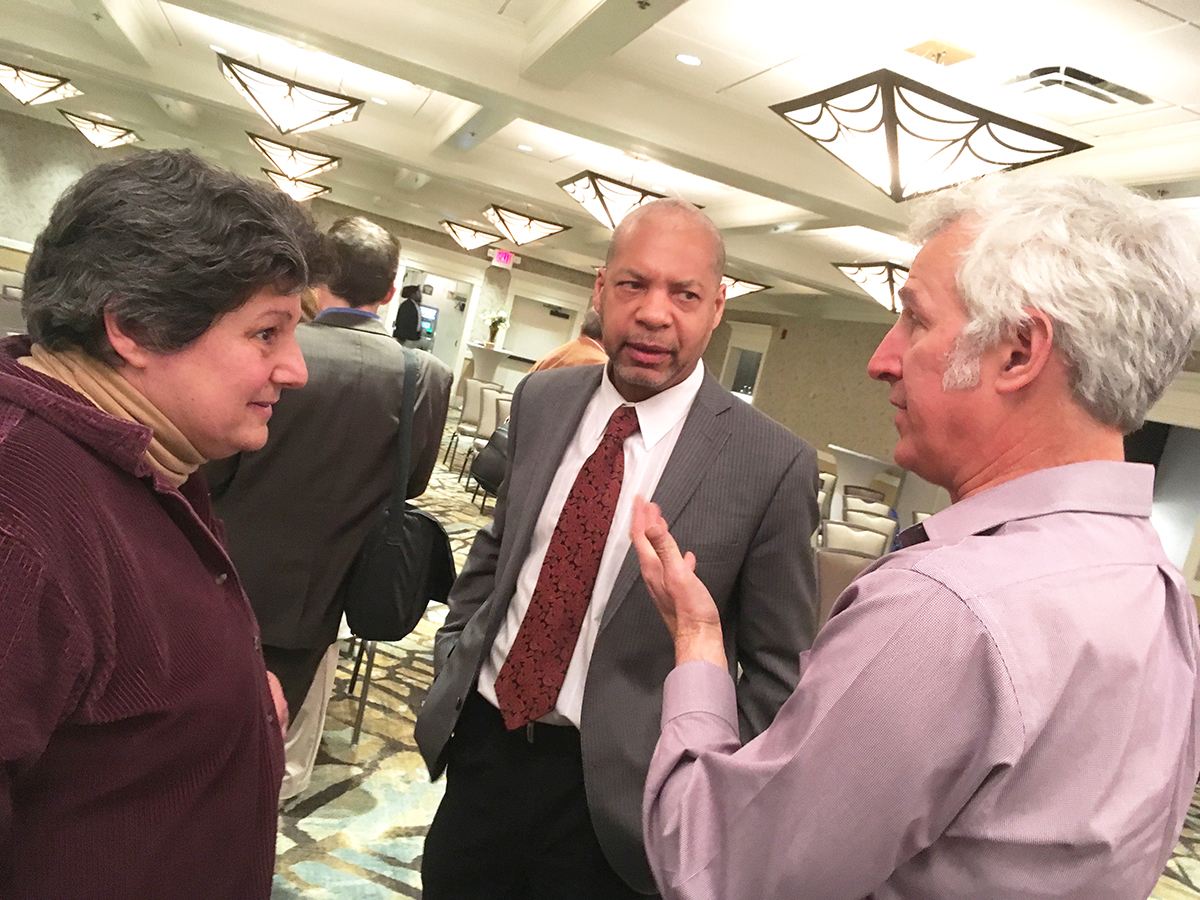Cornell leaders discuss Earth Source Heat at Ithaca forum
By Blaine Friedlander

Members of Cornell’s Senior Leaders Climate Action Group (SLCAG) presented highlights of their report, “Options for Achieving a Carbon Neutral Campus by 2035,” at a public meeting March 28 in downtown Ithaca.
SLCAG co-chair Lance Collins, the Joseph Silbert Dean of Engineering, discussed options for increasing clean energy supply on campus, and co-chair Bill Sitzabee, interim vice president for infrastructure, properties and planning, explained the university’s efforts to reduce energy demand.
Cornell’s large campus and northeastern location present challenges to achieving carbon neutrality. In its report, the group considered sustainable energy technologies and a multipronged approach to reducing demand and increasing supply. SCLAG ultimately recommended moving ahead with enhanced geothermal, wind, water, solar and biomass, Collins said.
The university has made strides in using solar energy, with five solar farms providing about 7 percent of the campus’s electricity needs. But heating the campus efficiently and sustainably is the biggest challenge to meeting the 2035 goal.
“We would like to heat the campus with enhanced geothermal energy, or what we are calling ‘Earth Source Heat,’” Collins said, as he explained a campus schematic showing how the system would work. Water would be circulated in a closed-loop system: It would be heated to near boiling in wells drilled to a depth of 10,000-15,000 feet, then returned to the surface, where it would go through heat exchangers to heat other water, which then would be distributed across campus to heat buildings.
“It’s exactly what we do with Lake Source Cooling, but in reverse,” he said. “Cornell has experience building systems of this sort.”
Making Earth Source Heat a reality will be an enormous undertaking, from raising funds from external sources to developing new technologies, and it will need to be implemented in stages, Collins said. In the initial phase, which will take a year, Cornell will apply for permits, design and site a test well, and engage the community. The second phase will raise more funds and drill the well to assess system feasibility and risk. Collins expects the second phase, which will also analyze the geology under Ithaca, to last about two years. In phase three, the university will drill a second well and assess the small, closed-loop water system created by the well pair. The third phase will take approximately three years. The fourth phase – a full-scale system – will take about 10 years to complete.
In preparation, Katie Keranen, assistant professor of earth and atmospheric sciences, explained that she and her students have deployed seismometers around campus to gain baseline insight. Keranen will continue to collect seismic and geologic data, and to examine it with Larry Brown, the Sidney Kaufman Professor in Geophysics.
Local resident Kathryn Russell, a former SUNY Cortland philosophy professor who identified herself as an anti-fracking activist, questioned whether Earth Source Heat would be similar to fracking. She said that deep wells would go through the Marcellus shale thousands of feet below, and she was concerned that pipe casing could be inadequate.
Anthony Ingraffea, the Dwight C. Baum Professor in Engineering, sitting in the audience, agreed that the water-loop system going through the Utica and Marcellus shale would need properly engineered casing.
Jeff Tester, the Croll Professor of Sustainable Energy Systems, explained that low-pressure, water-loop geothermal heating systems are very different from natural gas fracking. “We are not producing hydrocarbons … so our objective is not procuring hydrocarbons. Rather, we are producing low-pressure water that we have to manage effectively. For any geothermal operation, we have to ensure longevity.”
Gas fracking systems have a short production lifetime, Tester said: “Since we pay a lot through drilling to deliver this heat to the surface, there is a vested interest to do this right.”
Beyond the literal nuts and bolts of finding solutions to achieve carbon neutrality, Collins discussed the educational benefits that sustainability research brings and that projects provide for students, referring to campus as a “living laboratory.” Said Collins: “This provides big motivation for me, as my real goal as a dean is to educate students.”
Panelist Bob Howarth, the David R. Atkinson Professor of Ecology and Environmental Biology, apprised the community members that faculty are examining how to teach issues in sustainability across campus. “We want to bring carbon literacy into our curriculum,” he said.
Irene Weiser, a town council member from Caroline, New York, and a self-described anti-fracking activist, thanked the panelists for educating and collaborating with the community. In addition, she expressed appreciation for several Cornell faculty and staff members who have helped on sustainability-related community projects.
Media Contact
Get Cornell news delivered right to your inbox.
Subscribe